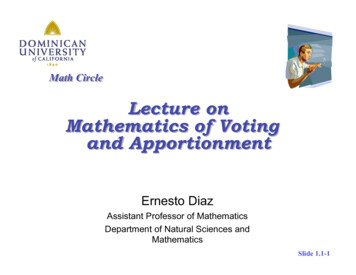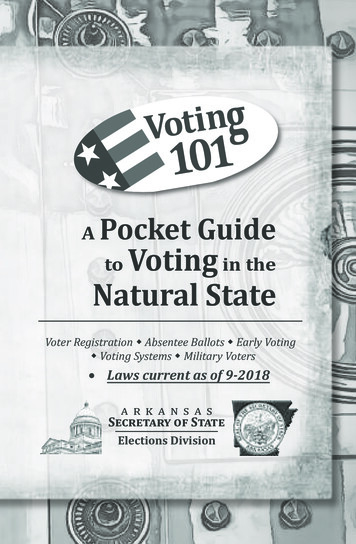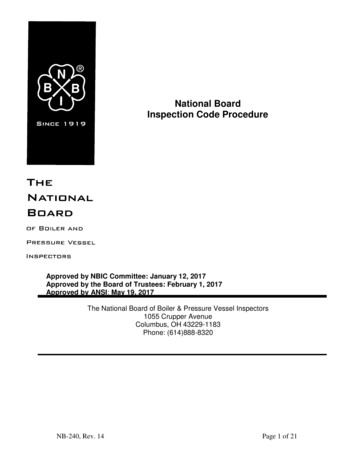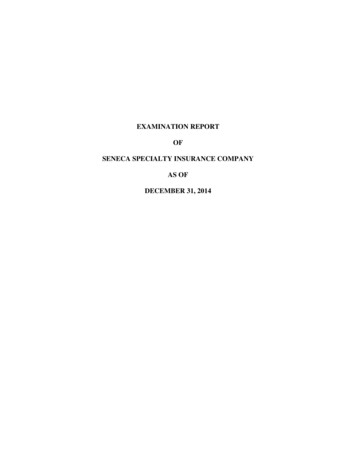
Transcription
Math CircleLecture onMathematics of Votingand ApportionmentErnesto DiazAssistant Professor of MathematicsDepartment of Natural Sciences andMathematicsSlide 1.1-1
1 The Mathematics of VotingThe Paradoxes of Democracy Vote! In a democracy, the rights and dutiesof citizenship are captured in that simpleone-word mantra. We vote in presidential elections,gubernatorial elections, local elections,school bonds, stadium bonds, American Idolselections, and initiatives large and small.Copyright 2010 Pearson Education, Inc.Excursions in Modern Mathematics, 7e: 1.1 - 2
1 The Mathematics of VotingThe Paradoxes of Democracy The paradox is that the more opportunitieswe have to vote, the less we seem toappreciate and understand the meaning ofvoting. Why should we vote? Does our vote really count? How does it count?Copyright 2010 Pearson Education, Inc.Excursions in Modern Mathematics, 7e: 1.1 - 3
1 The Mathematics of VotingVoting Theory First half is voting; Second half is counting. Arrow’s impossibility theorem:A method for determining election resultsthat is democratic and always fair is amathematical impossibility.Copyright 2010 Pearson Education, Inc.Excursions in Modern Mathematics, 7e: 1.1 - 4
1 The Mathematics of Voting1.1 Preference Ballots and PreferenceSchedules1.2 The Plurality Method1.3 The Borda Count MethodCopyright 2010 Pearson Education, Inc.Excursions in Modern Mathematics, 7e: 1.1 - 5
Example 1.1 The Math Club ElectionThe Math Appreciation Society (MAS) is a studentorganization dedicated to an unsung but worthy cause, thatof fostering the enjoyment and appreciation of mathematicsamong college students. The Tasmania State Universitychapter of MAS is holding its annual election for president.There are four candidates running for president: Alisha,Boris, Carmen, and Dave (A, B, C, and D for short). Each ofthe 37 members of the club votes by means of a ballotindicating his or her first, second, third, and fourth choice.The 37 ballots submitted are shown on the next slide. Oncethe ballots are in, it’s decision time. Who should be thewinner of the election? Why?Copyright 2010 Pearson Education, Inc.Excursions in Modern Mathematics, 7e: 1.1 - 6
Example 1.1 The Math Club ElectionCopyright 2010 Pearson Education, Inc.Excursions in Modern Mathematics, 7e: 1.1 - 7
1 The Mathematics of Voting1.1 Preference Ballots and PreferenceSchedules1.2 The Plurality Method1.3 The Borda Count MethodCopyright 2010 Pearson Education, Inc.Excursions in Modern Mathematics, 7e: 1.2 - 8
Plurality Method Candidate with the most first-place votes (calledthe plurality candidate) wins Don’t need each voter to rank the candidates need only the voter’s first choice Vast majority of elections for political office in theUnited States are decided using the pluralitymethod Many drawbacks - other than its utter simplicity,the plurality method has little else going in itsfavorCopyright 2010 Pearson Education, Inc.Excursions in Modern Mathematics, 7e: 1.2 - 9
Example 1.2 The Math Club Election(Plurality)Under plurality:A gets 14 first-place votesB gets 4 first-place votesC gets 11 first-place votesD gets 8 first-place votesand the results are clear - A wins (Alisha)Copyright 2010 Pearson Education, Inc.Excursions in Modern Mathematics, 7e: 1.2 - 10
Majority CandidateThe allure of the plurality method lies in itssimplicity (voters have little patience forcomplicated procedures) and in the fact thatplurality is a natural extension of the principleof majority rule:In a democratic election between twocandidates, the candidate with a majority(more than half) of the votes should be thewinner.Copyright 2010 Pearson Education, Inc.Excursions in Modern Mathematics, 7e: 1.2 - 11
Problem with Majority Candidate Two candidates: a plurality candidate isalso a majority candidate - everythingworks out well Three or more candidates: there is noguarantee that there is going to be amajority candidateCopyright 2010 Pearson Education, Inc.Excursions in Modern Mathematics, 7e: 1.2 - 12
Problem with Majority CandidateIn the Math Club election: majority would require at least 19 firstplace votes (out of 37). Alisha, with 14 first-place votes, had aplurality (more than any other candidate)but was far from being a majority candidate With many candidates, the percentage ofthe vote needed to win under plurality canbe ridiculously lowCopyright 2010 Pearson Education, Inc.Excursions in Modern Mathematics, 7e: 1.2 - 13
Majority CriterionOne of the most basic expectations in ademocratic election is the notion that if thereis a majority candidate, then that candidateshould be the winner of the election.THE MAJORITY CRITERIONIf candidate X has a majority of the firstplace votes,then candidate X should bethe winner of the election.Copyright 2010 Pearson Education, Inc.Excursions in Modern Mathematics, 7e: 1.2 - 14
The Condorcet CriterionThe plurality method satisfies the majoritycriterion-that’s good!The principal weakness of the pluralitymethod is that it fails to take intoconsideration a voter’s other preferencesbeyond first choice and in so doing can leadto some very bad election results. Tounderscore the point, consider the followingexample.Copyright 2010 Pearson Education, Inc.Excursions in Modern Mathematics, 7e: 1.2 - 15
Example 1.3 The Marching Band ElectionTasmania State University has a superbmarching band. They are so good that thiscoming bowl season they have invitations toperform at five different bowl games: the RoseBowl (R), the Hula Bowl (H), the Fiesta Bowl (F),the Orange Bowl (O), and the Sugar Bowl (S).An election is held among the 100 members ofthe band to decide in which of the five bowlgames they will perform. A preference schedulegiving the results of the election is shown.Copyright 2010 Pearson Education, Inc.Excursions in Modern Mathematics, 7e: 1.2 - 16
Example 1.3 The Marching Band ElectionCopyright 2010 Pearson Education, Inc.Excursions in Modern Mathematics, 7e: 1.2 - 17
Example 1.3 The Marching Band Election Under the plurality method, Rose Bowl winswith 49 first-place votes Bad outcome - 51 voters have the RoseBowl as last choice Hula Bowl has 48 first-place votes and 52second-place votes Hula Bowl is a far better choice torepresent the wishes of the entire band.Copyright 2010 Pearson Education, Inc.Excursions in Modern Mathematics, 7e: 1.2 - 18
Condorcet CriterionA candidate preferred by a majority of thevoters over every other candidate when thecandidates are compared in head-to-headcomparisons is called a Condorcet candidateTHE CONDORCET CRITERIONIf candidate X is preferred by the votersover each of the other candidates in ahead-to-head comparison,then candidateX should be the winner of the election.Copyright 2010 Pearson Education, Inc.Excursions in Modern Mathematics, 7e: 1.2 - 19
Insincere VotingThe idea behind insincere voting (alsoknown as strategic voting) is simple: If weknow that the candidate we really wantdoesn’t have a chance of winning, then ratherthan “waste our vote” on our favoritecandidate we can cast it for a lesser choicewho has a better chance of winning theelection. In closely contested elections a fewinsincere voters can completely change theoutcome of an election.Copyright 2010 Pearson Education, Inc.Excursions in Modern Mathematics, 7e: 1.2 - 20
Example 1.4 The Marching Band ElectionGets ManipulatedCopyright 2010 Pearson Education, Inc.Excursions in Modern Mathematics, 7e: 1.2 - 21
Consequences of Insincere Voting Insincere voting common in real-worldelections 2000 and 2004 presidential elections:Close races, Ralph Nader lost many votes voters did not want to “waste their vote.” Independent and small party candidatesnever get a fair voice or fair level funding(need 5% of vote to qualify for federal funds) Entrenched two-party system, often givesvoters little real choiceCopyright 2010 Pearson Education, Inc.Excursions in Modern Mathematics, 7e: 1.2 - 22
1 The Mathematics of Voting1.1 Preference Ballots and Preference Schedules1.2 The Plurality Method1.3 The Borda Count MethodCopyright 2010 Pearson Education, Inc.Excursions in Modern Mathematics, 7e: 1.2 - 23
The Borda Count Method Each place on a ballot is assigned points With N candidates, 1 point for last place, 2points for second from last, and so on First-place vote is worth N points Tally points for each candidate separately Candidate with highest total is winner Candidate is called the Borda winnerCopyright 2010 Pearson Education, Inc.Excursions in Modern Mathematics, 7e: 1.2 - 24
Example 1.5 The Math Club Election(Borda Method)Let’s use the Borda count method to choosethe winner of the Math Appreciation Societyelection first introduced in Example 1.1. Table1-4 shows the point values under eachcolumn based on first place worth 4 points,second place worth 3 points, third place worth2 points, and fourth place worth 1 point.Copyright 2010 Pearson Education, Inc.Excursions in Modern Mathematics, 7e: 1.2 - 25
Example 1.5 The Math Club Election(Borda Method)Tally the points:A gets: 56 10 8 4 1 79 pointsB gets: 42 30 16 16 2 106 pointsC gets: 28 40 24 8 4 104 pointsD gets: 14 20 32 12 3 81 pointsThe Borda winner of this election is Boris!(Wasn’t Alisha the winner of this election underthe plurality method?)Copyright 2010 Pearson Education, Inc.Excursions in Modern Mathematics, 7e: 1.2 - 26
What’s wrong with the Borda Method?In contrast to the plurality method, the Bordacount method takes into account all theinformation provided in the voters’ preferenceballots, and the Borda winner is the candidatewith the best average ranking - the bestcompromise candidate if you will. On its face, theBorda count method seems like an excellent wayto take full consideration of the voter’spreferences, so indeed, what’s wrong with it?The next example illustrates some of theproblems with the Borda count method.Copyright 2010 Pearson Education, Inc.Excursions in Modern Mathematics, 7e: 1.2 - 27
What’s wrong with the Borda Method?The Borda Method violates two basic criteriaof fairness: Majority criterion Condorcet criterionDespite its flaws, experts in voting theory considerthe Borda count method one of the best, if not thevery best, method for deciding elections withmany candidates.Copyright 2010 Pearson Education, Inc.Excursions in Modern Mathematics, 7e: 1.2 - 28
Borda count method in Real Life individual sports awards (Heisman Trophywinner, NBA Rookie of the Year, NFL MVP,etc.) college football polls music industry awards hiring of school principals, universitypresidents, and corporate executivesCopyright 2010 Pearson Education, Inc.Excursions in Modern Mathematics, 7e: 1.2 - 29
2 The Mathematics of Power2.1 An Introduction to Weighted Voting2.2 The Banzhaf Power IndexCopyright 2010 Pearson Education, Inc.Excursions in Modern Mathematics, 7e: 2.1 - 30
Weighted VotingIn a democracy we take many things forgranted, not the least of which is the ideathat we are all equal. When it comes tovoting rights, the democratic ideal ofequality translates into the principle of oneperson-one vote. But is the principle of oneperson-one vote always fair? Should oneperson-one vote apply when the voters areinstitutions or governments, rather thanindividuals?Copyright 2010 Pearson Education, Inc.Excursions in Modern Mathematics, 7e: 2.1 - 31
Weighted VotingWhat we are talking about here is the exactopposite of the principle of one voter–onevote, a principle best described as onevoter–x votes and formally called weightedvoting. Weighted voting is not uncommon;we see examples of weighted voting inshareholder votes in corporations, inbusiness partnerships, in legislatures, in theUnited Nations, and, most infamously, in theway we elect the President of the UnitedStates.Copyright 2010 Pearson Education, Inc.Excursions in Modern Mathematics, 7e: 2.1 - 32
Electoral CollegeThe Electoral College consists of 51“voters”(each of the 50 states plus theDistrict of Columbia), each with a weightdetermined by the size of its Congressionaldelegation (number of Representatives andSenators). At one end of the spectrum isheavyweight California (with 55 electoralvotes); at the other end of the spectrum arelightweights like Wyoming, Montana, NorthDakota, and the District of Columbia (with apaltry 3 electoral votes). The other statesfall somewhere in between.Copyright 2010 Pearson Education, Inc.Excursions in Modern Mathematics, 7e: 2.1 - 33
Electoral CollegeThe 2000 and 2004 presidential electionsbrought to the surface, in a very dramaticway, the vagaries and complexities of theElectoral College system, and in particularthe pivotal role that a single state (Florida in2000, Ohio in 2004) can have in the finaloutcome of a presidential election.In this chapter we will look at themathematics behind weighted voting, with aparticular focus on the question of power.Copyright 2010 Pearson Education, Inc.Excursions in Modern Mathematics, 7e: 2.1 - 34
NotationThus, a generic weighted voting system withN players can be written as:GENERIC WEIGHTED VOTINGSYSTEM WITH N PLAYERS[q: w1, w2, , wN](with w1 w2 wN)Copyright 2010 Pearson Education, Inc.Excursions in Modern Mathematics, 7e: 2.1 - 35
Example 2.6 Unsuspecting DummiesFour college friends (P1, P2, P3, and P4)decide to go into business together. Three ofthe four (P1, P2, and P3) invest 10,000 each,and each gets 10 shares in the partnership.The fourth partner (P4) is a little short oncash, so he invests only 9000 and gets 9shares. As usual, one share equals one vote.The quota is set at 75%, which here meansq 30 out of a total of V 39 votes.Mathematically (i.e., stripped of all theirrelevant details of the story), this partnershipis just the weighted voting system[30: 10, 10, 10, 9].Copyright 2010 Pearson Education, Inc.Excursions in Modern Mathematics, 7e: 2.1 - 36
Example 2.6 Unsuspecting DummiesEverything seems fine with the partnershipuntil one day P4 wakes up to the realizationthat with the quota set at q 30 he iscompletely out of the decision-making loop:For a motion to pass P1, P2, and P3 all mustvote Yes, and at that point it makes nodifference how P4 votes. Thus, there is nevergoing to be a time when P4’s votes are goingto make a difference in the final outcome of avote. Surprisingly, P4–with almost as manyvotes as the other partners–is just a dummy!Copyright 2010 Pearson Education, Inc.Excursions in Modern Mathematics, 7e: 2.1 - 37
2 The Mathematics of Power2.1 An Introduction to Weighted Voting2.2 The Banzhaf Power IndexCopyright 2010 Pearson Education, Inc.Excursions in Modern Mathematics, 7e: 2.2 - 38
Weighted VotingIn weighted voting the player’s weights canbe deceiving. Sometimes a player with afew votes can have as much power as aplayer with many more votes (see Example2.4); sometimes two players have almost anequal number of votes, and yet one playerhas a lot of power and the other one hasnone (see Example 2.6).Copyright 2010 Pearson Education, Inc.Excursions in Modern Mathematics, 7e: 2.2 - 39
CoalitionsA coalition is any set of players who mightjoin forces and vote the same way. Inprinciple, we can have a coalition with asfew as one player and as many as allplayers. The coalition consisting of all theplayers is called the grand coalition. Sincecoalitions are just sets of players, the mostconvenient way to describe coalitionsmathematically is to use set notation. Forexample, the coalition consisting of playersP1, P2,and P3 can be written as the set{P1, P2, P3} (order does not matter).Copyright 2010 Pearson Education, Inc.Excursions in Modern Mathematics, 7e: 2.2 - 40
Example 2.8 The Weirdness ofParliamentary PoliticsThe Parliament of Icelandia has 200members, divided among three politicalparties: P1, P2, and P3, with 99, 98, and 3seats in Parliament, respectively. Decisionsare made by majority vote, which in this caserequires 101 out of the total 200 votes. Let’sassume, furthermore, that in Icelandiamembers of Parliament always vote alongparty lines (not voting with your party is veryunusual in parliamentary governments).Copyright 2010 Pearson Education, Inc.Excursions in Modern Mathematics, 7e: 2.2 - 41
Example 2.8 The Weirdness ofParliamentary PoliticsWe can think of the Parliament of Icelandia asthe weighted voting system [101: 99, 98, 3].In thisweightedvotingsystem wehave fourwinningcoalitions.Copyright 2010 Pearson Education, Inc.Excursions in Modern Mathematics, 7e: 2.2 - 42
Example 2.8 The Weirdness ofParliamentary PoliticsIn the two-party coalitions, both parties arecritical players (without both players thecoalition wouldn’t win); in the grand coalitionno party is critical–any two parties togetherhave enough votes to win. Each of the threeparties is critical the same number of times,and consequently, one could rightfully arguethat each of the three parties has the sameamount of power (never mind the fact thatone party has only 3 votes!).Copyright 2010 Pearson Education, Inc.Excursions in Modern Mathematics, 7e: 2.2 - 43
4 The Mathematics of Apportionment4.1 Apportionment Problems4.2 Hamilton’s Method and the Quota Rule4.3 The Alabama and Other Paradoxes4.4 Jefferson’s Method4.5 Adam’s Method4.6 Webster’s MethodCopyright 2010 Pearson Education, Inc.Excursions in Modern Mathematics, 7e: 4.1 - 44
ApportionmentWithout a doubt, the most important andheated debate at the ConstitutionalConvention concerned the makeup of thelegislature. The small states wanted all statesto have the same number of representatives;the larger states wanted some form ofproportional representation. TheConstitutional compromise, known as theConnecticut Plan, was a Senate, in whichevery state has two senators, and a House ofRepresentatives, in which each state has anumber of representatives that is a functionof its population.Copyright 2010 Pearson Education, Inc.Excursions in Modern Mathematics, 7e: 4.1 - 45
ApportionmentWhile the Constitution makes clear that seatsin the House of Representatives are to beallocated to the states based on theirpopulations (“According to their respectiveNumbers”), it does not prescribe a specificmethod for the calculations. Undoubtedly, theFounding Fathers felt that this was arelatively minor detail–a matter of simplearithmetic that could be easily figured out andagreed upon by reasonable people.Copyright 2010 Pearson Education, Inc.Excursions in Modern Mathematics, 7e: 4.1 - 46
ApportionmentCertainly it was not the kind of thing to cluttera Constitution with or spend time arguingover in the heat of the summer. What theFounding Fathers did not realize is thatArticle I, Section 2, set the Constitution of theUnited States into a collision course with amathematical iceberg known today (butcertainly not then) as the apportionmentproblem.Copyright 2010 Pearson Education, Inc.Excursions in Modern Mathematics, 7e: 4.1 - 47
Apportionment ProblemsObviously, the word apportion is the key wordin this chapter. There are two criticalelements in the dictionary definition of theword: (1) We are dividing and assigningthings, and (2) we are doing this on aproportional basis and in a planned,organized fashion.We will start this section with a pair ofexamples that illustrate the nature of theproblem we are dealing with. Theseexamples will raise several questions but notgive any answers. Most of the answers willcome later.Copyright 2010 Pearson Education, Inc.Excursions in Modern Mathematics, 7e: 4.1 - 48
Example 4.2 The IntergalacticCongress of UtopiaIt is the year 2525, and all the planets in theUtopia galaxy have finally signed a peacetreaty. Five of the planets (Alanos, Betta,Conii, Dugos, and Ellisium) decide to joinforces and form an Intergalactic Federation.The Federation will be ruled by anIntergalactic Congress consisting of 50“elders,” and the 50 seats in the IntergalacticCongress are to be apportioned among theplanets according to their respectivepopulations.Copyright 2010 Pearson Education, Inc.Excursions in Modern Mathematics, 7e: 4.1 - 49
Example 4.2 The IntergalacticCongress of UtopiaThe population data for each of the planets(in billions) are shown in Table 4-2. Based onthese population figures, what is the correctapportionment of seats to each planet?We’ll get back to this later . . .Copyright 2010 Pearson Education, Inc.Excursions in Modern Mathematics, 7e: 4.1 - 50
Apportionment: Basic Concepts andTerminologyThe basic elements of every apportionmentproblem are as follows:The “states”This is the term we will use to describe theparties having a stake in the apportionment.Unless they have specific names (Azucar,Bahia, etc.), we will use A1, A2, , AN, todenote the states.Copyright 2010 Pearson Education, Inc.Excursions in Modern Mathematics, 7e: 4.1 - 51
Apportionment: Basic Concepts andTerminologyThe “seats”This term describes the set of M identical,indivisible objects that are being dividedamong the N states. For convenience, we willassume that there are more seats than thereare states, thus ensuring that every state canpotentially get a seat. (This assumption doesnot imply that every state must get a seat!)Copyright 2010 Pearson Education, Inc.Excursions in Modern Mathematics, 7e: 4.1 - 52
Apportionment: Basic Concepts andTerminologyThe “populations”This is a set of N positive numbers (forsimplicity we will assume that they are wholenumbers) that are used as the basis for theapportionment of the seats to the states. Wewill use p1, p2, , pN, to denote the state’srespective populations and P to denote thetotal population P p1 p2 pN).Copyright 2010 Pearson Education, Inc.Excursions in Modern Mathematics, 7e: 4.1 - 53
Apportionment: Basic Concepts andTerminologyThe standard divisor(SD)This is the ratio of population to seats. Itgives us a unit of measurement (SD people 1 seat) for our apportionment calculations.Copyright 2010 Pearson Education, Inc.Excursions in Modern Mathematics, 7e: 4.1 - 54
Apportionment: Basic Concepts andTerminologyThe standard quotasThe standard quota of a state is the exactfractional number of seats that the statewould get if fractional seats were allowed.We will use the notation q1, q2, , qN todenote the standard quotas of the respectivestates. To find a state’s standard quota, wedivide the state’s population by the standarddivisor. (In general, the standard quotas canbe expressed as fractions or decimals–roundthem to two or three decimal places.)Copyright 2010 Pearson Education, Inc.Excursions in Modern Mathematics, 7e: 4.1 - 55
Apportionment: Basic Concepts andTerminologyUpper and lower quotasThe lower quota is the standard quotarounded down and the upper quota is thestandard quota rounded up. In the unlikelyevent that the standard quota is a wholenumber, the lower and upper quotas are thesame. We will use L’s to denote lower quotasand U’s to denote upper quotas. Forexample, the standard quota q1 32.92 haslower quota L1 32 and upper quota U1 33.Copyright 2010 Pearson Education, Inc.Excursions in Modern Mathematics, 7e: 4.1 - 56
Apportionment MethodsOur main goal in this chapter is to discover a“good” apportionment method–a reliableprocedure that (1) will always produce a validapportionment (exactly M seats areapportioned) and (2) will always produce a“fair” apportionment. In this quest we willdiscuss several different methods and findout what is good and bad about each one.Copyright 2010 Pearson Education, Inc.Excursions in Modern Mathematics, 7e: 4.1 - 57
4 The Mathematics of Apportionment4.1 Apportionment Problems4.2 Hamilton’s Method and the QuotaRule4.3 The Alabama and Other ParadoxesCopyright 2010 Pearson Education, Inc.Excursions in Modern Mathematics, 7e: 4.2 - 58
Hamilton’s MethodHamilton’s method can be described quitebriefly:Every state gets at least its lower quota. Asmany states as possible get their upperquota, with the one with highest residue(i.e.,fractional part) having first priority, theone with second highest residue secondpriority, and so on.A little more formally, it goes like this:Copyright 2010 Pearson Education, Inc.Excursions in Modern Mathematics, 7e: 4.2 - 59
HAMILTON’S METHODStep 1 Calculate each state’s standardquota.Step 2 Give to each state its lowerquota.Step 3 Give the surplus seats (one at atime) to the states with thelargest residues (fractionalparts) until there are no moresurplus seats.Copyright 2010 Pearson Education, Inc.Excursions in Modern Mathematics, 7e: 4.2 - 60
Example 4.4 Parador’s Congress(Hamilton’s Method)As promised, we are revisiting the ParadorCongress apportionment problem. We arenow going to find our first real solution to thisproblem–the solution given by Hamilton’smethod (sometimes, for the sake of brevity,we will call it the Hamilton apportionment).Table 4-6 shows all the details and speaks foritself. (Reminder: The standard quotas in thesecond row of the table were computed inExample 4.3.)Copyright 2010 Pearson Education, Inc.Excursions in Modern Mathematics, 7e: 4.2 - 61
Example 4.4 Parador’s Congress(Hamilton’s Method)Hamilton’s method (also known as Vinton’smethod or the method of largest remainders)was used in the United States only between1850 and 1900.Copyright 2010 Pearson Education, Inc.Excursions in Modern Mathematics, 7e: 4.2 - 62
Hamilton’s MethodHamilton’s method is still used today toapportion the legislatures of Costa Rica,Namibia, and Sweden.At first glance, Hamilton’s method appears tobe quite fair. It could be reasonably arguedthat Hamilton’s method has a major flaw inthe way it relies entirely on the size of theresidues without consideration of what thoseresidues represent as a percent of the state’spopulation. In so doing, Hamilton’s methodcreates a systematic bias in favor of largerstates over smaller ones.Copyright 2010 Pearson Education, Inc.Excursions in Modern Mathematics, 7e: 4.2 - 63
Hamilton’s MethodThis is bad–a good apportionment methodshould be population neutral, meaning that itshould not be biased in favor of large statesover small ones or vice versa.To be totally fair, Hamilton’s method has twoimportant things going for it: (1) It is very easyto understand, and (2) it satisfies anextremely important requirement for fairnesscalled the quota rule.Copyright 2010 Pearson Education, Inc.Excursions in Modern Mathematics, 7e: 4.2 - 64
QUOTA RULENo state should be apportioned anumber of seats smaller than its lowerquota or larger than its upper quota.(When a state is apportioned a numbersmaller than its lower quota, we call ita lower-quota violation; when a stateis apportioned a number larger than itsupper quota, we call it an upper-quotaviolation.)Copyright 2010 Pearson Education, Inc.Excursions in Modern Mathematics, 7e: 4.2 - 65
4 The Mathematics of Apportionment4.1 Apportionment Problems4.2 Hamilton’s Method and the Quota Rule4.3 The Alabama and Other ParadoxesCopyright 2010 Pearson Education, Inc.Excursions in Modern Mathematics, 7e: 4.3 - 66
Alabama Paradox - Hamilton’s MethodThe most serious (in fact, the fatal) flaw ofHamilton’s method is commonly known asthe Alabama paradox. In essence, theAlabama paradox occurs when an increasein the total number of seats beingapportioned, in and of itself, forces a state tolose one of its seats. The best way tounderstand what this means is to lookcarefully at the following example.Copyright 2010 Pearson Education, Inc.Excursions in Modern Mathematics, 7e: 4.3 - 67
Example 4.5 More Seats Means FewerSeatsThe small country of Calavos consists ofthree states: Bama, Tecos, and Ilnos. With atotal population of 20,000 and 200 seats inthe House of Representatives, theapportionment of the 200 seats underHamilton’s method is shown in Table 4-7.Copyright 2010 Pearson Education, Inc.Excursions in Modern Mathematics, 7e: 4.3 - 68
Example 4.5 More Seats Means FewerSeatsNow imagine that overnight the number ofseats is increased to 201, but nothing elsechanges. Since there is one more seat to giveout, the apportionment has to be recomputed.Copyright 2010 Pearson Education, Inc.Excursions in Modern Mathematics, 7e: 4.3 - 69
Example 4.5 More Seats Means FewerSeatsHere’s the new apportionment (Hamilton’smethod) for a House with 201 seats. (Noticethat for M 200, the SD is 100; for M 201,the SD drops to 99.5.)Copyright 2010 Pearson Education, Inc.Excursions in Modern Mathematics, 7e: 4.3 - 70
The Population ParadoxSometime in the early 1900s it wasdiscovered that under Hamilton’s method astate could potentially lose some seatsbecause its population got too big! Thisphenomenon is known as the populationparadox. To be more precise, the populationparadox occurs when state A loses a seat tostate B even though the population of A grewat a higher rate than the population of B. Tooweird to be true, you say? Check out the nextexample.Copyright 2010 Pearson Education, Inc.Excursions in Modern Mathematics, 7e: 4.3 - 71
Example 4.6 A Tale of Two PlanetsPart I. The Apportionment of 2525.The first Intergalactic Congress wasapportioned using Hamilton’s method, basedon the population figures (in billions) shown inthe second column of Table 4-10. (This is theapportionment problem discussed in Example4.2.) There were 50 seats apportioned.Copyright 2010 Pearson Education, Inc.Excursions in Modern Mathematics, 7e: 4.3 - 72
Example 4.6 A Tale of Two PlanetsPart I. The Apportionment of 2525.Copyright 2010 Pearson Education, Inc.Excursions in Modern Mathematics, 7e: 4.3 - 73
Example 4.6 A Tale of Two PlanetsPart II. The Apportionment of 2535.After 10 years of peace, all was well in theIntergalactic Federation. The IntergalacticCensus of 2535 showed only a few changesin
Jan 11, 2012 · Math Circle Lecture on Mathematics of Voting and Apportionment Ernesto Diaz . third place worth 2 points, and fourth place worth 1 point. Example 1.5 The Math Club Election . experts in voting theory consider the Borda count method one of the best, if










